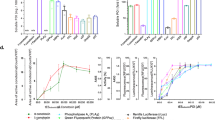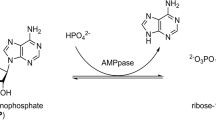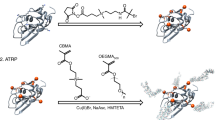Abstract
Previous studies on the refolding of recombinant bovine carbonic anhydrase B (CAB) indicated that polyethylene glycol (PEG) significantly enhanced the recovery of active protein by reducing aggregation. To further test the ability of PEG to enhance refolding, three recombinant human proteins, deoxyribonuclease (rhDNAse), tissue plasminogen activator (rhtPA), and interferon–gamma (rhIFN–γ) were refolded in the presence of PEG (3350 MW). rhDNAse produced from CHO cells was denatured in 7.2 M urea and refolded by rapid dilution to 4.0 M urea and 0.20 mg/ml protein. When a final PEG to rhDNAse molar ratio of 5 to 1 (0.1 g/l PEG, 3350 MW) was used in the dilution buffer, refolding was improved by 30% to yield complete recovery of active protein. Impure E. coli derived inclusion body preparations of rhDNAse were solubilized in 8 M urea and refolded by dilution to 4 M urea and 0.10 mg/ml protein. Refolding with a dilution buffer which yielded a final PEG to rhDNAse molar ratio of 10 to 1 (0.1 g/l PEG, 3350 MW) resulted in a three–fold increase in the recovery of active protein. When PEG was used in the dilution buffer, aggregation of rhDNAse did not occur during refolding in either case. rhtPA produced from CHO cells was denatured in 5 M guanidine hydrochloride (GuHCl) and refolded by rapid dilution to 0.10 M GuHCl and 0.20 mg/ml protein. Dilution to these conditions with a buffer containing a final molar ratio of PEG to rhtPA of 20 to 1 (0.19 g/I PEG, 3350 MW) resulted in a two fold increase in the recovery of proteolytically active rhtPA and protein aggregation was again prevented. E. coli derived rhIFN–γ was denatured in 4 M GuHCl and refolded by rapid dilution to 0.5 or 1.0 M GuHCl and 1.0 mg/ml protein. A PEG to rhIFN–γ molar ratio of 2 to 1 (0.38 g/l PEG, 3350 MW) increased the yield of active protein from 5% to greater than 30%. A good correlation was observed between the protein hydrophobicity and the stoichiome–tric concentration of PEG required to achieve a maximal increase in recovery of active protein. These refolding studies reveal that PEG has significant potential for enhancing the recovery of active proteins produced in heterologous hosts.
This is a preview of subscription content, access via your institution
Access options
Subscribe to this journal
Receive 12 print issues and online access
$209.00 per year
only $17.42 per issue
Buy this article
- Purchase on Springer Link
- Instant access to full article PDF
Prices may be subject to local taxes which are calculated during checkout
Similar content being viewed by others
References
Builder, S.E. and Ogez, J.R. 1985. Purification and activity assurance of precipitated heterologous proteins. U.S. Patent 4,511,502.
Builder, S.E. and Ogez, J.R. 1985. Purification and activily assurance of precipitated heterologous proteins. U.S. Patent 4,620,948.
Cleland, J.L. and Wang, D.I.C. 1990. Cosolvent assisted protein refolding. Bio/Technology 8: 1274–1278.
Tandon, S. and Horowitz, P.M. 1987. Detergent-assisted refolding of guanidinium chloride-denatured rhodanesc. J. Biol. Chem. 262: 4486–4491.
Rothman, J.E. 1989. Polypeptide chain binding proteins: catalysts of protein folding and related processes in cells. Cell 59: 591–601.
Cleland, J.L. and Randolph, T.W. 1992. Mechanism of polyethylene glycol interaction with the molten globule intermediate on the carbonic anhydrase folding pathway. J. Biol. Chem. 267: 3147–3153.
Cleland, J.L., Hedgepeth, C. and Wang, D.I.C. 1992 Polyethylene glycol enhanced refolding of bovine carbonic anhydrase B:Reaction stoichiometry and refolding model. J. Biol. Chem. In press.
Dolgikh, D.A., Kolomiets, A.P., Bolotina, I.A. and Ptitsyn, O.B. 1984 ‘Molten-globule’ state accumulates in carbonic anhydrase folding. FKBS Lett. 165: 88–92.
Cleland, J.L. and Wang, D.I.C. 1990 Refolding and aggregation of bovine carbonic anhydrase B: Quasi-elastic light scattering analysis. Biochemistry 29: 11072–11079.
Ptitsyn, O.B., Pain, R.H., Semisotnov, G.V., Zerovnik, K. and Razgulyaev, O.I. 1990. Evidence for a molten globule state as a general intermediate in protein folding. FEBS Lett. 262: 20–24.
Shak, S., Capon, D.J., Hellmiss, R., Marsters, S.A., and Baker, C.L. 1990. Recombinant human DNase I reduces the viscosity of cystic fibrosis sputum. Proc. Natl. Acad. Sci. USA 87: 9188–9192.
Spellman, M.W., Basa, L.J., Leonard, C.K., Chakel, J.A., O'Connor, J.V., Wilson, S. and van Halbeck, H. 1989. Carbohydrate structures of human tissue plasminogen activator expressed in Chinese hamster ovary cells. J. Biol. Chem. 264: 14100–14111.
Pennica, D., Holmes, W.K., Kohr, W.J., Harkins, R.N., Vehar, G.A., Ward, C.A., Bennett, W.F., Yelverton, K., Seeburg, P.H., Heyneker Gocddel, D.V. and Collen, D. 1983. Cloning and expression of human tissue-type plasminogen activator cDNA in E. coli. Nature 301: 214–221.
Loscalzo, J. 1988. Structural and kinetic comparison of recombinant human single-and two-chain tissue plasminogen activator. J. Clin. Invest. 82: 1391–1397.
Ealick, S.E., Cook, W.J., Vijay-Kumar, S., Carson, M., Nagabhushan, T.L., Trotta, P.P. and Bugg, C.E. 1991. Three-dimensional structure of recombinant human inlerferon-γ. Science 252: 698–702.
Rinderknecht, E., O'Connor, B.H. and Rodriguez, H. 1984. Natural human interferon-γ:Complete amino acid sequence and determination of sites of glycosylation. J. Biol. Chem. 259: 6790–6797.
Hart, R. and Bailey, J.E. 1992. Solubilization and regeneration of Vitre-oscilla hemoglobin isolated from protein inclusion bodies. Biotech. Bioeng. 39: 1112–1120.
Suck, D., Oefner, C. and Kabsch, W. 1984. Three dimensional structure of bovine pancreatic DNase I at 2.5 Å resolution. EMBO J. 3: 2423–2430.
Liljas, A., Kannan, K.K., Bergstén, P.-C., Waara, I., Fridborg, K., Strandberg, B., Carlbom, U., Jårup, L., Lovgren, S. and Petef, M. 1972. Structure of human carbonic anhydrase C. Nature 235: 131–137.
Cleland, J.L. 1991. Mechanisms of protein aggregation and refolding. Doctoral Thesis Dissertation. Department of Chemical Engineering, Massachusetts Institute of Technology, Cambridge, MA.
Sarimientos, P., Duchesne, M., Denéfle, P., Boiziau, J., Fromage, N., Delporte, N., Parker, F., Leliévre, Y., Mayaux, J.-F. and Cartwright, I. 1989. Synthesis and purification of active human tissue plasminogen activator from Escherichia coli. Bio/Technology. 7: 495–501.
Wang, L.-F., Hum, W.T., Kalyan, N.K., Lee, S.G., Hung, P.P. and Doi, R.H. 1989. Synthesis and refolding of human tissue-type plasminogen activator in Bacillus subtilis. Gene 84: 127–133.
Eisenberg, D., Weiss, R.M., Terwilliger, T.C. and Wilcox, W. 1982. Hydro-phobic moments and protein structure. Faraday Symp. Chem. Soc. 17: 109–120.
Janin, J. 1979. Surface and inside volumes of globular proteins. Nature 277: 491–492.
Nozaki, Y. and Tanford, C. 1971. The solubility of amino acids and two glycine peptides in aqueous ethanol and dioxane solutions: Establishment of a hydrophobicity scale. J. Biol. Chem. 246: 2211–2217.
Arakawa, T., Bhat, R. and Timasheff, S.N. 1990. Mechanism of polyethylene glycol interaction. Biochemistry 29: 1924–1930.
Martin, J., Langer, T., Boteva, R., Schramel, A., Horwich, A.L. and Hartl, F.-U. 1991. Chaperonin-mediated protein folding at the surface of groEL through a ‘molten globule’ like intermediate. Nature 352: 36–42.
Cleland, J.L. and Wang, D.I.C. 1992. Cosolvent effects on refolding and aggregation. In: Biocatalyst Design for Stability and Specificity. Geor giou, G. and Himmel, M. (Eds.). A.C.S. Symposium Series, American Chemical Society, Washington, DC. In press.
Friberger, P. 1982. Chromogenic peptide substrates:Their use for assay of factors in the fibrinolytic and the plasma kallikrein-kinin systems. Scand. J. Clin. Lab. Invest. 42(S162): 15–98.
Yeh, T.-J., McBride, P. and Overall, J. 1982. Automated quantitative cyto-pathic effect assay for inlcrferon. J. Clin. Microbiol. 16: 413–415.
Author information
Authors and Affiliations
Rights and permissions
About this article
Cite this article
Cleland, J., Builder, S., Swartz, J. et al. Polyethylene Glycol Enhanced Protein Refolding. Nat Biotechnol 10, 1013–1019 (1992). https://doi.org/10.1038/nbt0992-1013
Received:
Accepted:
Issue Date:
DOI: https://doi.org/10.1038/nbt0992-1013
This article is cited by
-
Microwave assisted solubilization of inclusion bodies
Sustainable Chemical Processes (2013)
-
A New Artificial Chaperone for Protein Refolding: Sequential Use of Detergent and Alginate
The Protein Journal (2008)
-
Comparative Evaluation of α-Amylase Refolding Through Two Different Artificial Chaperone Systems
The Protein Journal (2007)



